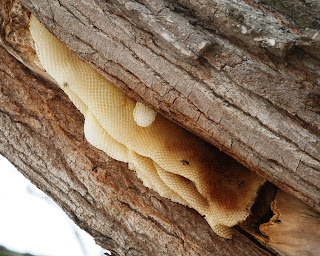Early spring bee hive inspections give the beekeeper an opportunity to determine the health of the colony and the condition of its queen. Inspections also allow the beekeeper to analyze and start taking corrective action for hive or colony problems. In the inspection, we look at the size of the population of bees and examine the brood. A hive with a smaller population than others being inspected at the same time may have a failing queen. Much can be learned about the queen’s productivity by examining the different stages of brood. Because of the amount of time that the brood remains in each of the different stages of development, we can determine if there is continuity in the queen’s egg laying by roughly counting the brood. When she is laying, there will be twice as many larvae as eggs and twice as many pupae as larvae. For example, finding capped brood but no uncapped brood may mean that the queen has stopped laying eggs.
Honey bee eggs and larvae are pearly white in color, and are found in open cells and should not be discolored. Pupae are housed in capped cells, which should have even-shaped cappings made of recycled beeswax. The brood should never have an unpleasant odor. Observing the appearance, texture, and odor of brood can usually identify two serious brood diseases, American foulbrood and European foulbrood. However, there is a very common bee hive condition that is similar in appearance and often tricky to identify. It is chilled brood caused by having a portion of the comb exposed to cold or damp conditions without being covered by protective bees. Chilled brood may have discolored larvae similar to European foulbrood or eneven, discolored, and perforated cappings like American foulbrood. There may be an unpleasant odor as well from decaying bees and brood. The chilled brood and dead bees in today’s photo resulted from vandals exposing a hive to the elements. Knowing the hive’s history helps identify chilled brood.
--Richard













